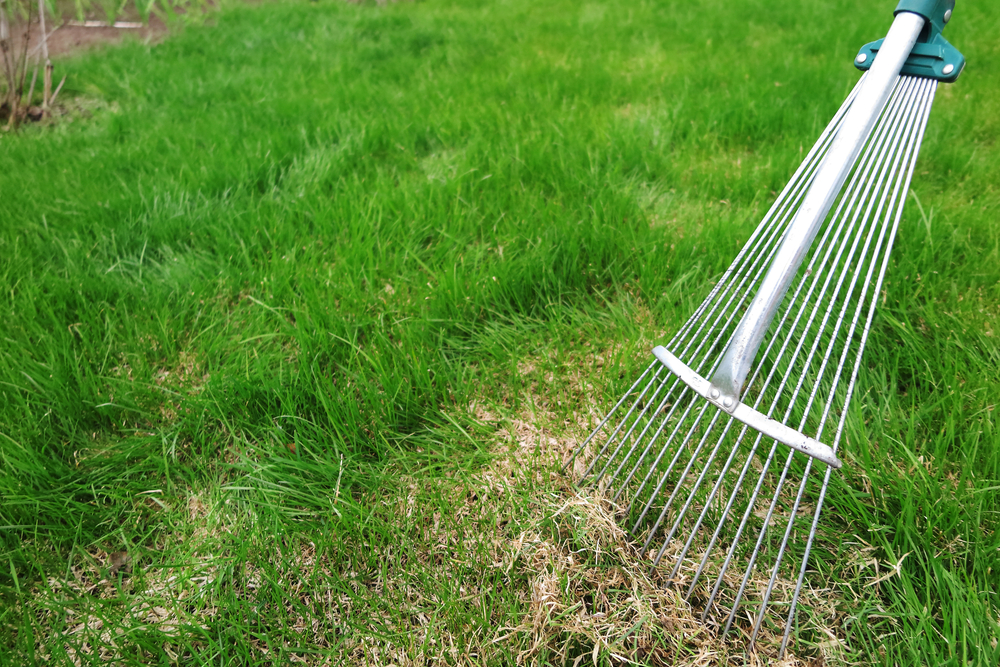Lawn care comes with its own vocabulary, which can make it challenging to know if you’re doing things correctly. From aeration to overseeding, the terms can be confusing for homeowners striving to maintain a healthy, vibrant lawn. One term that often pops up when discussing how to care for your lawn is “dethatching.” Homeowners often wonder, “What is dethatching?” and “Is it necessary for my lawn?” We’re here to unravel all the mysteries surrounding thatch and the process of dethatching a lawn.
In essence, dethatching is the process of removing the layer of organic matter, known as thatch, that accumulates between the soil surface and the green grass blades. This blog will explore what dethatching is, the benefits it provides, and how to go about it effectively.
Understanding the Basics of Dethatching
Dethatching is the process of removing the layer of organic matter known as thatch that accumulates between the soil surface and the green vegetation of your lawn. Thatch is composed of dead grass, roots, and other organic materials that haven’t decomposed properly. When thatch layers become too thick (more than half an inch thick), they can create a barrier that prevents water, nutrients, and air from reaching the soil and grassroots, leading to unhealthy lawns.
The Significance of Dethatching
Removing thatch is vital for maintaining a healthy lawn because it allows your grass to receive the essential elements it needs to thrive. Without dethatching, your lawn can suffer from compacted soil, poor water absorption, and increased susceptibility to pests and diseases. Yard dethatchers, which include both manual and mechanical tools, are designed to break up and remove this thatch layer, promoting better lawn health.
Common Misconceptions About Dethatching
Many homeowners believe that grass clippings cause thatch, but this is not entirely true. Thatch is primarily composed of slow-decomposing organic matter like stems, stolons, and roots rather than grass clippings. Thatch problems arise primarily from poor soil conditions and the overuse of fertilizers and pesticides.
Another misconception is that dethatching damages lawns irreparably. While aggressive dethatching can harm the grass, proper dethatching, especially when done at the right time for cool-season grasses or warm-season grasses, significantly enhances lawn health. Understanding the truth behind these myths will help you address problems with thatch properly.
What Is Dethatching a Lawn, and How Does It Work?
Dethatching involves using specialized tools to cut through the thatch layer and bring it to the surface, where it can be removed. Tools like dethatching rakes or power rakes are commonly used for this purpose. A lawn dethatcher, also known as a dethatching machine, uses tines or blades to slice through the thatch and lift it out of the lawn.
The Benefits of Dethatching
Dethatching offers several benefits that contribute to a lush, green lawn:
- Improved Air and Water Flow: Dethatching opens up the soil, allowing better air and water penetration.
- Enhanced Nutrient Absorption: With the thatch layer removed, grass roots can access nutrients more effectively.
- Stronger Grass Growth: Dethatching stimulates new growth, leading to a thicker, healthier lawn.
- Reduced Pest and Disease Risks: By eliminating the thatch layer, you remove a potential breeding ground for pests and diseases.
When to Dethatch a Lawn
It’s essential to know when to dethatch; when done correctly and at the right time, it can significantly benefit your lawn. For cool-season grasses, early fall or spring is ideal, while warm-season grasses should be dethatched in late spring to early summer. Timing is crucial to ensure the grass has ample time to recover and grow vigorously.
How to Dethatch a Lawn
Now that you have a grasp on what dethatching does, it’s time to learn how to properly dethatch your yard. Follow this step-by-step guide to do it properly:
- Evaluate Thatch Buildup: Before starting, check if your lawn has a thatch problem. Use a spade to remove a small section of your lawn. If the thatch layer is more than half an inch thick, it’s time to dethatch your lawn.
- Select the Proper Tool: Depending on your lawn size, choose a manual yard dethatcher or a power rake. For large areas, a power rake is more efficient.
- Prepare Your Lawn: Mow your lawn to half its usual height and water it lightly to soften the soil.
- Dethatch the Lawn: Using your chosen tool, work the dethatcher over your lawn, making multiple passes in different directions to ensure thorough thatch removal.
- Cleanup: Rake up the thatch debris and remove it from your lawn.
- Post-Dethatching Care: After dethatching, fertilize and water your lawn to promote recovery and new growth. Overseed if necessary to fill in any bare spots.
Hire a Professional for Optimal Results
While dethatching your lawn by yourself is possible, hiring a professional ensures the job is done efficiently and with minimal risk of damage to your lawn. Professionals like The Lawn Care Company have the experience and equipment to assess thatch problems accurately and use the appropriate methods for your specific lawn type.
Enhance the Health of Your Lawn by Getting Rid of Thatch
Dethatching is an essential lawn care practice that can transform the health and appearance of your lawn. By understanding what dethatching is and how to do it properly, you can maintain a lush, vibrant yard that is free of problems.
For optimal results and peace of mind, consider booking a professional dethatching service with The Lawn Care Company. Our experts are equipped with the knowledge and tools to remove thatch and promote healthy lawns. Contact us today to book an appointment!

